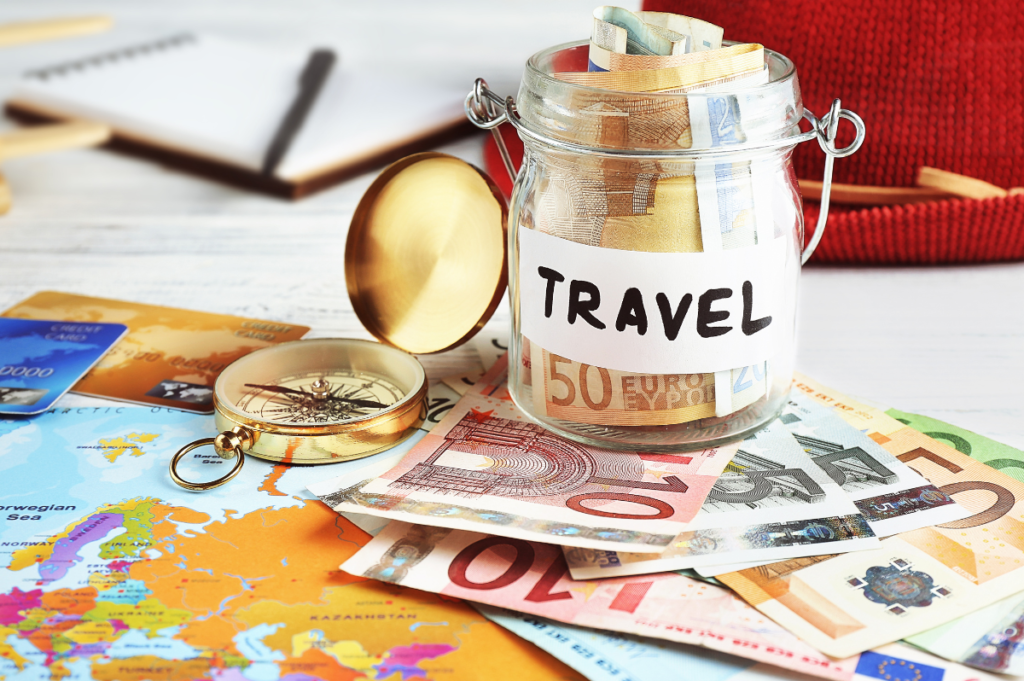You’ve probably seen influencers online boast about how they’re flying business class and staying in five-star hotels “for free”. I’ll be perfectly honest with you, it’s not actually free, but if you’re careful with it, you can make it pretty darn close!
Learning how to travel on points and miles is an absolute game changer! In this guide, I’m going to explain everything you need to know to get started. I promise it’s not as complicated as it’s made to seem!
Difference Between Airline Miles and Credit Card Points
Points and miles are relatively interchangeable in terms of language. At least when it comes to the airline piece.
Airline miles are what you earn from a flight purchase made in cash and are specifically for that airline you flew. Technically, it can get more complicated, but we’re not going to get into that here. As an example, if you fly on Delta you would earn miles on that flight in their native currency, Delta Skymiles. How much you earn depends on a variety of factors such as the class of your ticket, distance flown, elite status, etc. This varies by airline, but those miles can be used for future Delta flights or Delta partner flights only.
Credit card points are different. You earn these when making everyday purchases on your credit card, and they’ll be in the native currency of that bank, such as Capital One Miles or Chase Ultimate Reward Points. Think of credit card points as a stem cell (sorry I was a health science major in college), it’s a cell but not specific to anything like a heart or muscle cell. You can then take those points and transfer them out to travel partners. Which in turn converts them into a specific kind of currency (or cell), such as United Miles or AAdvantage Miles.
The cool thing about credit card points is that they’re flexible! However, once you transfer them out to a partner, you can never transfer them back. So make sure you’re only transferring when you’re ready to actually book a flight or hotel.
TLDR is airline miles are specific for that airline, while credit card points can be converted into points for a specific airline or hotel.
Choosing the Right Credit Card
This is going to vary a ton based on your specific spending habits! Are you a foodie? Traveling twice a month? Only on a plane once a year? Can’t be bothered with varying multipliers?
I can’t tell you what to pick since it’s personalized to your lifestyle. Each bank will have different travel partners, which can also play a factor into which institution you want to go with. If you’re a big fan of Hyatt, then you’ll want a card that can transfer into their points program. It wouldn’t make sense to sign up for a card that doesn’t have the brand you like to use.
You’ll also want to focus on a card that will earn you the most points in your highest spend categories. For example, if you like to dine out, getting a card that you can earn 3x per dollar on restaurants on would make the most sense. If you don’t want to worry about categories at all, maybe look at a card with a flat earning rate. As a rule of thumb, I’d say you always want to try and get more than 1x per dollar on your spend. But, if you’re just starting out in this game, don’t sweat it too much.
Welcome Offers
These are the large stash of points the bank promotes you’ll earn when you meet a specific amount of spend within a certain timeframe of opening the card. On average, it’s about $4,000 in approximately three months, for personal cards. Business cards are an entire different ball game on spending requirements.
Banks will have a standard welcome offer of somewhere between 60k-75k points/miles. This is typically never the option you want to take. Throughout the year, banks will promote elevated welcome offers to get people to apply for the card. These usually include elevated points and/or one time travel credits.
- As an example, a bank might run a standard welcome offer of 60k points. For two months the welcome offer is 75k points and a one-time $250 travel credit to use in their portal.
- Another example could be a bank has a standard offer of 75k points and is running a promotion for 120k points but requires $5,000 spend in 3 months compared to the usual $4,000.

Another way to get elevated offers is through targeted offers. You might get these in the mail, email, or can even check for them using special tools online. In the end, you want to get a card when there’s an elevated offer, and you can comfortably meet the spending requirements. Think right before booking a vacation or another large purchase like a home remodel or a move. Missing out on a welcome bonus/sign-up bonus (SUB) sucks, but don’t spend money you don’t have to get it either.
It’s also NOT the end of the world if you sign up for a credit card when there’s no special welcome bonus. This is simply the best time, as this is when most people earn the bulk of their points. I have signed up for a card once with a standard welcome offer. Getting it at that time fit my life more to meet the bonus than to wait for a better one to come out where I might not have been able to. I also needed some of the perks it offered for a bunch of upcoming travel, so it does happen!
Annual Fees
These are what tend to scare off a lot of people from entering the points and miles world. “Why on earth would I pay for a credit card??”
Ok, I hear you! Especially since some of the annual fees out there on the higher tier cards are looking like a monthly mortgage or car payment. Annual fees are essentially what you pay to access the rewards program that the bank offers, as well as the transfer partners they contract with each year. These are typically charged on the anniversary of your account. They often range from $95~$795. We’re seeing a lot of programs getting revamped lately, so these numbers might increase. Yikes.
Don’t let this immediately scare you! There’s also the idea of the “net annual fee” which is the value you’ve received from the card minus the annual fee. This is usually highest the first year you have the card thanks to the welcome bonus and then each year after by how you use your credits.
As an example, one of my cards has an annual fee of $95, and I received an 85k point welcome offer when I applied for the card. Additionally, this card comes with an annual $50 hotel credit to use in their travel portal. Off the bat, if I use that $50 credit, my net annual fee is already down to $45. Now if we look at that 85k welcome bonus at face value, it’s worth $850 if redeeming at 1 cent per point. However, could be worth $1.7k or more if transferred out to partners normally or using transfer bonuses. So now my net annual fee is between -$805 to -$1,655 which means the bank paid me to have this card!
As I said, the first year is almost always going to be where you get the most return. However, if you strategize your credits and make it worth holding you can get your net annual fee each year to be super low, $0, or even negative. Just choose the card that works best for your lifestyle!
If at some point an annual fee becomes too much for you to justify, you can always call the bank to try and get a retention offer or downgrade to a cheaper or no annual fee card. A retention offer would be a reduced or waived fee, or extra points to your account to keep you as a customer. If you go this route, make sure you’re polite to the person on the other end of the phone! Kindness really goes a long way in these conversations. They may also just say no, and at that point you can decide what to do: keep it, downgrade, or cancel.
Just be careful when canceling because your credit report will take a hit for the decreased total credit, shortened credit length, etc. You’ll usually lose a few points, but should recover in a few months on average.
Spending Categories
These are going to be one of the other big factors that will help you determine which card or cards fit your spending habits and lifestyle best. Each card will have their own multiplier for a spending category. You want to use the one that will give you the most points back on your purchase.
These are usually things like: Groceries, Restaurants, Travel, Subscription Services, a Specific Store or Brand, Other Spending, etc.
If you have two cards and one gives you 3x on groceries while the other is only 1x, use the card that gives you 3x to earn points faster!

Redeeming Points – Travel Portal vs Transferring
It can be great looking at a huge stack of points and feeling “rich”! Points devalue all the time and the whole reason we earn them is to use them. Can’t travel for free if we never redeem the points…..right??
Travel Portal
The bank’s travel portal is essentially an online travel agency, similar to Expedia. Here is where you’ll see the lowest value for your points of, typically a 1:1 redemption value. Sometimes 1:1.25 or 1:1.5 depending on your card and bank. Generally, it’s pretty capped. This isn’t necessarily all bad! For some, this might be a clean and easy way to redeem your points if you don’t care about maximizing value. It’s still a free plane ticket or hotel stay!
More perks to booking in a bank’s travel portal are not having to pay taxes and fees. You do have to pay these on reward tickets directly with airlines. Also you can book hotels that can’t normally be booked with points. Many smaller or boutique hotels don’t have loyalty programs. If you book directly, it must be done in cash. However, if they’re on a bank portal you can book that stay with points, which you wouldn’t otherwise be able to do. Woo hoo!
In the end, the travel portal has its place and can be a loophole to booking places not otherwise bookable with points. However, it’s not my first option as the value of your points is severely limited. As one more note, not every flight and fare type is always available through the portal either!

Transfer Partners
Transfer partners are where the real value for your points comes in! Transferring your points is a slightly more complicated process so bare with me as I try to break this down 101 style.
Each bank has different airlines and hotels they contract with. Which is big thing to pay attention to when picking a card! When beginning your search make sure you’re only looking at airlines and hotels you can transfer to if you’re planning on using points. It would really suck to find an amazing points deal and then realize you can’t book it!
To actually transfer points to your airline or hotel membership account, you’ll need to add your rewards number to your credit card’s transfer portal. Once you’ve done this, you’re golden and don’t need to do it again!
Most banks allow you transfer out points in increments of 1,000 at a 1:1 ratio. So you’re not going to be able to send the exact amount you need, sorry! However, this can definitely vary and this doesn’t take into account things like transfer bonuses. After you’ve confirmed how many points you want to transfer, send them over! Many points should be available within a few minutes, but others might take 24-72 hours. So don’t freak out if it takes a little bit. My first IHG point transfer from Chase took three days and it definitely worried me at first, but they did arrive! Please be sure you’re ready to make a purchase before you transfer. They can never be transferred back!

Airlines
There are many ways these days to find reward flights. My favorite way is to use the Points Path extension with Google Flights! When running a search for a flight the extension will also show you the points price if one is available, which banks you can use to transfer to it, and whether they think it’s a good points value or not. If the value is bad they’ll also suggest you use cash as it would mathmatically be the cheaper option based on the price per point value.
Many other tools for finding points deals are also out there. Most of them will only work on one-way flights, which can be a bit annoying if you’re trying to book roundtrip. There are a mix of free and paid options so play around to see what suits you best!
Hotels
From my experience, finding hotel reward availability is done directly through the brand’s website. You would click a button on the search that says “Use Points”, “Award Availability”, or something similar.
Hotel reward rates can vary wildly based on where the hotel is, how many stars it has, or if the date you’re picking is on or off-peak. Sometimes you can pay different rates per night! Just like with booking a flight, once you find a hotel and rate you’re happy with, transfer over your points! A fun difference here is you often don’t have to pay taxes and fees on award bookings like you do on a flight. The whole thing is covered by points!
If you want to know if you’re getting a good deal or not, I love The Points Guy’s Award vs Cash Calculator! What’s so nice is it does airlines and hotels.

Other Strategies to Travel for Free
Flight Alerts
Once you start getting into points and miles it can feel daunting trying to find the best deals to make sure you’re not wasting your hard earned points. It can also take hours if you try to do it manually. No thank you!
If you have specific destinations in mind you can set alerts with services like Roame Travel, Seats.aero, Going, and Points Path. These have both free and premium options. Personally, I do have a Points Path Founder’s Club annual membership and a Going Premium membership!
For general point searches you can use all the above tools as well as Daily Drop Pro (subscription only).
Housesitting
This is a unique way to have free accomodation with a little bit of responsibility while on your trip! If you don’t mind taking care of someone’s plants, home, and/or pets in exchange for a place to sleep this can save you hundreds or thousands of dollars (or whatever your currency is). Note that you do have to apply and be approved in order to stay. The biggest platform is Trusted Housesitters.
What’s in My Wallet
Ok! So after all that talk of credit cards and transferring points, you’re probably wondering, “so which cards do you have?”. Do remember that what works for me, may not work for you!
BILT Mastercard

This was my very first transferrable points card! What’s so nice about the BILT Mastercard is it has no annual fee (it’s currently undergoing some program restucturing for 2026 so this might change). It has access to amazing transfer partners like Alaska Airlines and Hyatt! This is incredibly rare in the points and miles world for no annual fee!
The big kicker when I got this card was that you’re able to use it to pay rent and earn points with no transacation fee. This is amazing if you live in a place like NYC like me! You can technically pay rent on any credit card. It’s the transacation fee that’s the killer, but not with BILT! I was now able to earn points on my biggest expense of the month. It has now covered multiple plane tickets including my first ever reward ticket! Booking that first ticket on points was such and amazing feeling and I’m now addicted….
Another thing to note here is that the card does require a minimum of five transacations per month in order to earn points. This is to make sure you’re not just using it on rent and nothing else, which…..boooooo! It’s still a great card though as it earns 3x on dining and 2x on travel. The travel category is more limited than some other cards out there. Such as you need to book directly with the provider like Delta or Hyatt, not through a third-party like Expedia. If you do book through an online travel agency you’ll only earn 1x per dollar. Public transit like the NYC MTA also doesn’t code as travel. Since BILT points are so valuable, being able to transfer them to Alaska, this is my main card for dining out!
Chase Sapphire Preferred

The Chase Sapphire Preferred was my first mid-tier travel card! This is a great card for beginners and comes with a very modest $95 annual fee. I won’t lie this one was a tad tricky to get for me. I was denied the first time I applied online. The second time around I applied in-branch during an elevated sign-up offer of 75k points after spending $4,000 in the first three months. I also got an additional 10k for signing up at the branch when I spent another $2,000 in two months after meeting the first bonus. So in the end I got a bonus of 85k points for $6,000 worth of spend over a five month period. Thankfully I had enough going on at the time I was able to meet this!
Chase has an unofficial 5/24 rule. This means if you’ve been approved for five new credit lines within 24 months you’ll be automatically denied. This isn’t always true, but it’s something to keep in mind if you’re looking at cards with Chase. Better to apply earlier on than after you’ve opened a few other cards.
Chase earns Ultimate Rewards Points and can be used in their travel portal or transferred out to partners like United, IHG, and Hyatt! The card also comes with a $50 annual hotel credit to use in their travel portal. This card also has elevated point offers (must be activated), 2x on travel, 3x on dining, 3x on select streaming, 3x on online groceries, 3x on Lyft, 3x on Chase Travel, and 1x on everything else. I love using this card for travel purchases as well as my Netflix subscription! I’m also a huge fan of the online Asian grocer Weee so earning 3x points there is amazing.
Capital One Venture X

If you’re looking to get into the world of premium travel cards the Capital One Venture X is a great place to start! It boasts a lower annual fee of $395. Compare this to others such as the AMEX Platinum for $695 or the Chase Sapphire Reserve for $795. It’s the most afforadable, especially for everything you get.
This card has a simple 2x multiplier on all purchases (except in their travel portal). This makes it my fallback card for anything that doesn’t have an elevated earning rate on another card. I use it all the time! I also love this card because it comes with an annual $300 travel credit, Priority Pass membership (must enroll), access to Capital One Lounges, $120 Global Entry reimbursement every five years, a 10k point anniversary bonus (worth at least $100), and more! Its annual fee is essentially wiped out!
Another great thing about this card is you can use your points to cover travel purchases at a 1:1 ratio on your statement after you’ve made them! So want to cover that car rental with points? Or that budget airline flight you can’t transfer to? Done!
Capital One can be finicky about approvals and even the major points and miles blogs out there don’t totally understand what criteria they’re looking for. A helpful thing to see if you’re eligible is their pre-approval tool. They do a soft pull to see if you might qualify. This is often a good indicator if you’ll pass the hard pull but still not a guaruntee. I’ve also read stories of people failing the pre-approval and then being approved when they applied. If you want this card I would definitely try the pre-approval first. Capital One pulls from all three credit breaus so better to only apply when you’re confident you’ll get it.
This is actually the card I applied for when it didn’t have an elevated offer. I could comfortably meet the spending requirements before making a big life change that would hinder my ability to meet the sign-up bonus. I needed (wanted honestly) the perks of the card for the life change. So I took the plunge and applied after passing the pre-approval tool and got the standard 75k point bonus.
Final Thoughts
Is the travel really free? Well no, not always. Especially if you have to pay taxes and fees on flights despite transferring your points. However, using points and miles can give you experiences you never imagined you could have. Think business and first class flights, stays in five star hotels, or being able to take a trip in general you might not have been able to afford otherwise.
I was hestitant before getting my first credit card with an annual fee. It seemed insane to pay to have a credit card! Now that I have them, I’m grateful I do. They’ve allowed me to do things like flying to my parents last minute round-trip for 9.5k points and $35 and also flying one-way to Australia for 42.5k and $38 in taxes. Yes. I got a ticket flying almost 10k miles for $38.
Making sure I applied for cards that made sense for me and had credits I could use to justify the annual fees was super important. I’m also ok redeeming my points for flights in economy as it extends them so I can fly more. If you want to use them for premium experiences that’s great! The beauty is you get to use them how you want to.
Make sure you’re paying your statement balances off every single month! Otherwise, the points aren’t worth it if you’re paying interest. Take it from someone who learned some very expensive lessons in their early twenties. Only spend what you can comfortably pay off each month. Happy redeeming!

















